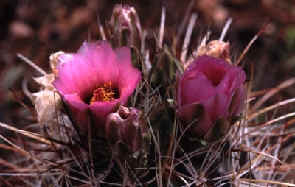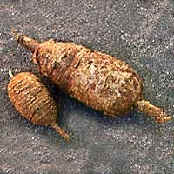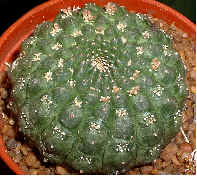Devil’s
Claw - an endangered species?
Cactus Cowboy
Antenna Covers
Guess the
species - Answer.
Parallelizing
Algorithms and the cactus world
Some
new words for your spell checker...
|
Devil’s
Claw - an endangered species?
I was flicking through the ‘life’
section of the Times when a picture of a Sclerocactus in flower caught my eye.
The caption said ‘devil’s claw’, which is the common name for the cactus
and the article was about herbal medicines. What possible connection was there
between a Sclerocactus and home remedies? Surely, you weren’t supposed to eat
them?
Apparently so…“Bioforce
used to buy devil’s claw on the open market but it recognised that random
harvesting would soon cause extinction – since 15 million plants are pulled up
from the Kalahari Desert every year”.
Every year! 15 million
Sclerocactus! No wonder they are hard to find! But surely that should be an
American Desert? The article continued…”The clamour is all for the plant’s
tuber…”
Then I realised; the article
was about another devil’s claw, Harpagophytum procumbens and the Times
had committed a bit of a booboo. Still it made me chuckle.
The tuberous devil’s claw
gets its name from hooks on the fruit and is a treatment for arthritis.
Naturally
use of the relevant Latin names would have prevented any confusion. |

|
|

|
Above: The real devil’s claw
from Utah.
Left: The real devil’s claw
from the Kalahari.
|
Thanks now to
Desert.com for bringing us this must-have accessory….
|

|
Cactus
Cowboy Antenna Covers
Unique antenna cover.
Hard to find.
Drive around with a little of the Southwest with you.
Makes your car easy to
spot. Can be mounted high on the antenna or pushed down to car surface as
shown. Small gasket fits over top the hat to hold it down and keep it from
blowing off.
Photo shows how it looks mounted.
Great Gift Idea!
Color of cowboy hat, sunglasses and kerchief may vary.
Your Price:
$10.95
Also Available in: Glow
In The Dark
Ed:
Sue says she must have the ‘Glow in the Dark’ model! |
| Guess the
species - Answer.
The sentence from the
Editorial is a quote
from an interesting article on Euphorbia gymnocalycioides in the
December 2004 US Journal, (available from the branch library). This
species was described in 1984 and I see it fairly frequently in
collections and on the show-bench. Sometimes it is grafted. Coming from
Ethiopia it is not likely to survive the Ed’s winter
regime which is far more suited to Gymnocalyciums. |

|
Parallelizing
Algorithms and the cactus world
You may not be aware that a
cactus means different things to different people, this is especially so on the
internet, where parallel meanings jostle for space; for example from the website
cactuscode.org I found the following headings:
- The Cactus Framework and Toolkit: Design
and Applications
- Grid Aware Parallelizing Algorithms
- The Cactus Worm: Experiments with Dynamic
Resource Discovery and Allocation in a Grid Environment
- Supporting Efficient Execution in
Heterogeneous Distributed Computing Environments with Cactus and Globus
- Cactus Grid Computing: Review of Current
Development
- A Parallel Chemical Reaction Simulation
Using Cactus
Goodness knows what this lot
means. You see that when we say ‘cactus’ we mean one thing but lots of
people think of something else. On the internet the word ‘cactus’ has a
major presence concerned with computing (as above), boxing, things that ladies
might do (but probably not the ladies we know) and in connection with the Austin
University, Texas - it is their Yearbook.
Rest assured that when you
murmur the sweet word ‘cactus’ (plural ‘cacti’) at your local BCSS
meeting no one will be thinking ‘Grid Aware Parallelizing Algorithms’. And
if they did they would know how to spell it!
However should you have
actually read the erudite headings from cactuscode you may have noticed a cactus
worm (an amazing 248,000 hits, = pages, on Google!) lurking there. I might
guess, reading some of these pages that this mostly gobbles computer
hard-drives. The natural world has a parallel and there is a worm
called Cactoblastis which gobbles cacti (just 190 pages of information on
the net) – both the Opuntia weeds of Australia and also the rarer more select
Sclerocactus of the US southwest. A mixed blessing ecologically, though, when I
see a hollowed ruin of Sclerocactus in habitat there is definitely a feeling of
loss.
Some new
words for your spell checker...
I expect you knew that hybrids
are often named after a combination of the names of the genera. Hence
Pachgerocereus is the natural hybrid Pachycereus X Bergerocactus found in Baja
California. This was in some correspondence from Leo Martin of Arizona from the
internet postings of Cactus_etc which may amuse….
Echinocereus triglochidiatus
has been slow to bloom… The Echinocereus engelmannii are late too... I crossed
the two to see what would happen. Can anyone tell me what I'll get?
E. x
terniggellomcahnindiiiatus or E. x etnrgiegllmoacnhniidiiatus depending on which
one is the pod parent. Better change your labels now.
Thanks Leo!




